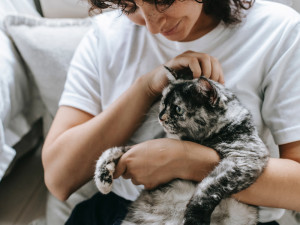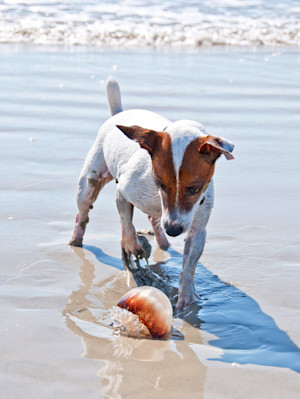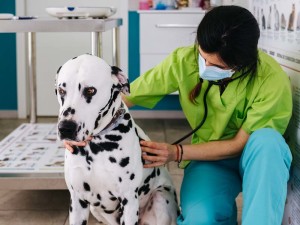Absolutely Everything That Should Be In Your Pet’s First Aid Kit
Get your kit sorted now so you’re ready in an emergency

Share Article
If you’re a pet parent, you may have already had the inevitable panic about your beloved cat or dog getting injured. Maybe you have already experienced the haunting situation and even felt that you could have been better prepared. The thing is, whilst many households will have some kind of human first aid kit, very few have a pet version.
A pet first aid kit is crucial for every pet parent. It should it be something that pet people keep in both the cupboard and in car. After working in the veterinary professionopens in a new tab for over three decades I have seen my fair share of bloodopens in a new tab and gore. The right first aid treatment can be vital when dealing with an emergency. However, without the right preparation, knowledge and equipment to hand, pet parents can go into panic mode when it comes to managing a first aid emergency.

littleKin™ is Kinship’s home just for puppy and kitten parents. Bop over to check out expert advice, new pet tools, and special deals—all curated for your newest family member.
opens in a new tabAlways be prepared
When you’re walking your dog, always be mindful of the potential for injury and be vigilant to what‘s around you. In the UK, there can be a number of known threats to pup in the outdoor worldopens in a new tab so always do your research – especially if you are visiting rural areas, or areas unfamiliar to you.
When we let our cats outopens in a new tab they are usually wise in keeping themselves safe, however, accidents do happen. Whether you have a cat, a dog, or both, every pet parent should think about taking a pet first aid course and consider attending a practical workshopopens in a new tab if they are available in your area.
On top of this, having a well-stocked first aid kit for your pet can be a lifesaver in emergencies. Ahead, I outline the essential items to include in your kit which will help you be prepared to handle a variety of emergencies until you can get to a veterinary surgeon.
What should be in my pet first aid kit?
The basics
First aid manual for pets: a comprehensive guidebook can provide step-by-step instructions for a wide range of emergencies.
Emergency contact numbers: include your registered veterinary surgeon’s contact numbers and the protocol for out-of-hours provision.
Numbers for 24-hour helplines: many insurance companies now include 24-hour vet advice lines within the policy so ensure you do your homework to see if this is available to you.
Your pet’s medical records: keep a copy of your pet’s vaccination records, medical history (including any known allergiesopens in a new tab) and a list of any medication they are currently receiving.
Wound care
Antiseptic solution: chlorhexidine or povidone iodine can be used to clean wounds and prevent infection.
Gauze pad or rolls: these are essential for dressing wounds and can be used to control bleeding.
Adhesive tape and bandages: use pet-safe adhesive tape and cohesive type bandages to secure dressings without sticking to the fur. I really like this brandopens in a new tab as they are good quality and lay well on the pet. On the plus side, they also come in lots of funky designs.
Styptic powder or pencil: this helps stop minor bleeding, especially from nail trims.
Medications and treatments
Antihistamines: some human antihistamines can be given to your pet. Please ensure you speak to your veterinary surgeon first to get a correct dose for your pet’s body weight.
Activated charcoal: can help absorb toxinsopens in a new tab in cases of poisoning if indicated. Please consult your veterinary surgeon.
Eye wash solution: saline solution can be used to flush out debris from your pets eyes and also to flush out wounds.
Ear cleaning solution: keeping your pet’s earsopens in a new tab clean can help prevent infections. Always read the instructions and discuss the need with your veterinary surgeon.
Pain relief: only use pet specific medication as human medications can be harmful. Always consult your veterinary surgeon before administrating.
Tools and equipment
Digital thermometer: this can be a useful addition to check your pet’s temperatureopens in a new tab. Ensure you know the normal ranges for your pet. Generally, between 38.3–38.7C is normal for a dog and 38–38.5C degrees is normal for a cat.
Tweezers: useful for removing splinters, grass seeds and other foreign objects.
Tick remover: this may be your most used piece of equipment during the hotter months. Ticksopens in a new tab are zoonotic which means they pose a threat to humans by transmitting disease. The Tick Twister®opens in a new tab is one of my favourite tick removers as once you have hooked the twister on between the tick and the pet, you just twist like undoing a screw. Tweezer-type tick removers mean you have to hold together and turn at the same time which is much more complicated when your dog's a wriggler.
Scissors: blunt ended, curved scissors like theseopens in a new tab ones are safer for trimming fur around wounds because you're cutting away from the skin.
Syringe: useful if needing to administer oral treatment or flushing wounds.
Disposable gloves: it is always good practice to protect yourself whilst treating your pet's injuries.
Muzzle: even the gentlest of pets may bite when in pain. A muzzleopens in a new tab can protect you and them.
Restraint items: a leash, collar, harness and blanket can help safely transport an injured pet.
Comfort Items
Blanket or towel: this can provide warmth and comfort and can also be used as a stretcher.
Pet carrieropens in a new tab: needed for safe transport especially if your pet is frightened. It can prevent further injury.
Other essentials
Treats: your pet's favourite treats can be useful for calming pets, however sometimes they may not be eaten if your pet is too anxious.
Notepad and pen: use these for recording symptoms, times, and any treatments that may have been administered, this will be useful when a medical history is needed.
Having a well-stocked first aid kit could make a significant difference in an emergency situation and help you provide immediate care and comfort to your furry friend. Regularly check and update your kit to ensure all items are within their expiration dates and replenish any used supplies. By being proactive you can ensure that you’re ready to handle your pet’s health emergency efficiently and effectively.
Common pet first aid emergencies and what to do
Ahead is a list of first aid situations may you be exposed to as a pet owner and what can you should do to help.
Bleeding
Apply pressure with a clean cloth or gauze, depending on the area a bandage can be used to hold the dressing in place. Read more about how to help a bleeding petopens in a new tab.
Wounds
Clean with diluted antiseptic solution and cover with a bandage.
Heatstroke
Move to a cool area, offer water and apply cool (not cold) wet towels to the body. Find out more on how to prevent and treat heatstroke in dogsopens in a new tab and heatstroke in catsopens in a new tab.
Poisoning
Call your vet surgeon immediately, do not induce vomiting unless directed. Here's more information about what to do when your dog eats something toxicopens in a new tab.
Insect Stings
Remove the stinger with tweezers and apply a cold compress. Read more about what to do if your dog gets stung by a beeopens in a new tab and how this differs for your catopens in a new tab hereopens in a new tab.
Burns
Rinse with cold water and cover with a non-stick bandage. Avoid any creams or ointments until advised by a vet.
As much as we can prepare for these situations when they actually do happen it is very easy to forget everything and go into flight mode. Always try and remain calm, take a few slow deep breaths and you will be much more help to your pet.

Zoe Blake RVN, ISFMCertFN / AdvCertFB, MISAP
Zoe is a registered veterinary nurse and has been in the profession for over 30 years. She enjoys educating pet owners on all aspects of their care and regularly writes to support her work. When she is not chatting animals, she can be found running around the tennis court or exploring the countryside with her rescue dog, Dylan.
Related articles
![Jack Russell dog on beach looking at a jellyfish]() opens in a new tab
opens in a new tabA British Guide to the Countryside – For City Dogs
From thorns and grass seeds to more insidious threats such as snake bites and jellyfish stings, there’s a lot to watch out for
![]() opens in a new tab
opens in a new tabHow to Keep Your Cat Cool and Prevent Heat-Stroke
Summer safety is vital for cats
![Uncomfortable looking gray cat sitting on a window sill]() opens in a new tab
opens in a new tabShould Your Cat Go to A&E?
Here are six good reasons to haul tail to A&E
![Red cat with squinted eyes laying in a basket closeup]() opens in a new tab
opens in a new tab6 Ways Your Cat Could Tell You They Are in Pain
Here are all the way your kitty is trying to tell you they’re hurting
![French bulldog puppy looking scared at vet]() opens in a new tab
opens in a new tab10 Things to Ask At Your First Vet Visit
There are no stupid questions when it comes to your dog’s health
![Dalmatian and Great Dane mixed dog at the vet being checked on by a nurse in bright green scrubs]() opens in a new tab
opens in a new tabBeware of Bloat in Dogs
Consider it the mother of all dog emergencies – if your dog has it, take them to the vet ASAP. Learn how to spot the condition and how it’s treated








